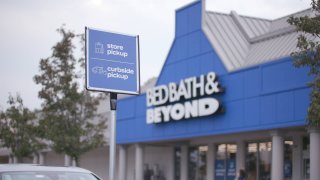
- Bed Bath & Beyond reported mixed fiscal first-quarter results, as sales topped analysts' estimates, but profits missed.
- Costs tied to the retailer's turnaround efforts, including marketing expenses, weighed on margins.
- The company raised its full-year revenue outlook ahead of the key back-to-school shopping season.
Bed Bath & Beyond fiscal first-quarter sales climbed nearly 50%, as the retailer's turnaround initiatives including launching new brands and remodeling stores helped to draw in customers for everything from blenders to bath mats.
The progress coming ahead of the key back-to-school shopping season was enough for the company to hike its full-year revenue outlook.
However, its first-quarter earnings were hurt and will continue to be weighed down by the costs that Bed Bath & Beyond faces in order to successfully turn its business around.
Get top local stories in San Diego delivered to you every morning. >Sign up for NBC San Diego's News Headlines newsletter.
"We're in the early stages of our transformation," Chief Executive Mark Tritton said during an earnings conference call. "Our first-quarter results prove we continue to deliver profitable growth as we reestablish our authority in home."
Bed Bath & Beyond shares were surging about 19% in mid-morning trading amid heavy volume. After its earnings were released, shares initally fell but then reversed course and began rising. By 10:30 a.m. ET more than 23 million shares had changed hands, compared with the stock's 10-day average volume of 5.7 million.
Part of Wednesday's gains may be attributed to a short squeeze. Nearly 20% of Bed Bath & Beyond shares available for trading are sold short, according to the latest numbers from FactSet. That's a relatively high amount, and about on par with other so-called meme favorites GameStop and AMC. A short squeeze happens when investors who are betting against the stock are forced to buy back the shares to cover their losses.
Money Report
The retailer's stock has occassionally been pulled into the meme trading frenzy, which has taken off on the social platform Reddit. Ahead of Wednesday's results, Bank of America analyst Curtis Nagle said the shares had resumed trading at "pre-surge levels."
Here's what Bed Bath & Beyond reported for the three months ended May 29, compared with what Wall Street was expecting, based on a survey of analysts by Refinitiv:
- Earnings per share: 5 cents adjusted vs. 8 cents expected
- Revenue: $1.95 billion vs. $1.87 billion expected
Bed Bath & Beyond said its net loss narrowed to $51 million, or 48 cents per share, from a loss of $302 million, or $2.44 per share, a year earlier. Excluding one-time charges related to asset sales and other turnaround initiatives, the company earned 5 cents per share, which came in short of the 8 cents per share that analysts had expected.
Net sales climbed 49% to $1.95 billion from $1.3 billion a year earlier, beating expectations for $1.87 billion.
Digital sales accounted for 38% of total sales, as some customers opted to browse and buy online and pick their orders up at nearby Bed Bath & Beyond locations later that same day. Last month, the company partnered with DoorDash to offer same-day delivery to shoppers' homes.
The company said its so-called core sales — which consists of revenue from Bed Bath & Beyond, Buybuy Baby, Harmon Face Values and Decorist — rose 73% year over year. At Bed Bath & Beyond, growth in bedding, bath, kitchen food prep and indoor decor items outpaced other categories.
Comparable sales — which track revenue online and at shops open for at least 12 months — were up 86% compared with 2020 levels, and up 3% on a two-year basis. Analysts had been looking for year-over-year growth of 75.6%, according to StreetAccount estimates.
Comparable sales were adjusted to account for the negative impact of ongoing store closures. Locations that permanently closed in fiscal 2020 would have contributed roughly 13% to the retailer's core sales during the fiscal first quarter, the company said in its news release. As of May 29, the retailer operated a total of 1,004 stores, including 818 of its namesake Bed Bath & Beyond locations.
So far, a key component of Bed Bath & Beyond's turnaround plans is ahead of schedule. It's in the process of debuting a variety of in-house brands across the kitchen, bedding and organization categories.
By 2023, the company says its private-label sales will grow to represent 30% of its business, from about 10% at the end of last year. By selling more in-house products, Bed Bath & Beyond's goal is to grow margins. This is one way the company can hopefully offset some of the hefty expenses it incurs as it invests in things like refreshing stores. The retailer expects to remodel as many as 150 locations in North America this fiscal year.
During its fiscal first quarter, Bed Bath & Beyond launched the bedding and bath label Nestwell, a spa-inspired line Haven and an everyday basics line called Simply Essential. It has a number of other labels on the way.
It has also been ramping up marketing in a bid to make itself known as a destination for all things home. A national TV and social media campaign called "Home, Happier" recently debuted.
"We have started the year in a position of strength and are clearly on track to accomplish our goals," Tritton said.
Bed Bath & Beyond raised its full-year revenue outlook to a range of $8.2 billion to $8.4 billion, up from a prior estimate of $8 billion to $8.2 billion. Fiscal 2021 earnings are expected to be between $1.40 and $1.55 per share, on an adjusted basis. Analysts had been looking for full-year adjusted earnings of $1.47 a share on revenue of $8.15 billion.
For the second quarter, Bed Bath & Beyond said it expects to earn between 48 cents and 55 cents per share after adjustments. Sales will be between $2.04 billion and $2.08 billion.
Analysts had been looking for second-quarter adjusted earnings of 52 cents per share on sales of $2.02 billion, according to Refinitiv data.
Bed Bath & Beyond, meantime, is the latest retailer to sweeten benefits for workers. The company is providing as much as eight weeks of paid leave to parents after the birth, adoption or fostering of a new child. Many businesses have been investing in better wages and benefits as a way to attract employees in a tight labor market.






